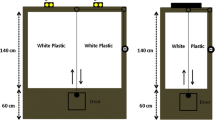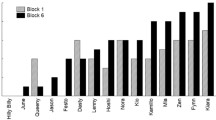Abstract
Discrimination learning studies suggest that horses learn more easily using spatial than visible object-specific (OS) cues. However, spatial cues have generally confounded intra-array, distal and/or egocentric spatial information. It is also unclear whether conflicting cues compete for association or are redundantly encoded, and furthermore, the influence of prior experiences or training has not been quantified so far. We examined the effect of cue modality on unweaned foals’ performance in a discrimination learning task. After a pilot study confirmed that horses could perform the required OS cue discrimination, nine foals learnt to find food in one of three covered buckets, in any of four positions within a test arena. In Stage 1 the rewarded bucket was signified both by OS cues (pattern) and by relative spatial cues (position). On reaching criterion, cues were separated and foals had to ignore the inappropriate cue (Stage 2). Foals assigned to follow spatial cues (n = 5) completed Stage 2 faster than foals for whom OS cues remained consistent (n = 4). Spatial group foals all reached criterion without delay; no foal in the OS group reached criterion within the testing period. OS group foals initially persisted in responding to the previously correct position, adopting spatially-based strategies when this proved unsuccessful. The findings show for the first time that, even in the absence of distal spatial information, intra-array spatial cues were more salient than OS cues for foals in a food-finding task and learning appeared rather inflexible.




Similar content being viewed by others
References
Bottom SH, Owen H, Lawson RE, Harris PA, Hall S (2004) Equine feeding side preference—incidence and age effect. In: Alliston J, Chadd S, Ede A, Hemmings A, Hyslop J, Longland A, Moreton H, Moore-Colyer M (eds) Emerging equine science. Nottingham University Press, Nottingham, pp 223–225
Brodbeck DR (1994) Memory for spatial and local cues—a comparison of a storing and a nonstoring species. Anim Learn Behav 22:119–133
Brodbeck DR, Shettleworth SJ (1995) Matching location and color of a compound stimulus—comparison of a food-storing and a nonstoring bird species. J Exp Psychol 21:64–77
Brown GS (1994) Spatial association learning by rufous hummingbirds (Selasphorus rufus): effects of relative spacing among stimuli. J Comp Psychol 108:29–35
Bruce V, Green P, Georgeson M (1996) Visual perception: physiology, psychology and ecology, 3rd edn. Psychology Press, Hove
Church DL, Plowright CMS (2006) Spatial encoding by bumblebees (Bombus impatiens) of a reward within an artificial flower array. Anim Cogn 9:131–140. doi:10.1007/s10071-005-0011-6
Clayton NS, Krebs JR (1994) Memory for spatial and object-specific cues in food-storing and nonstoring birds. J Comp Physiol A 174:371–379
Cohen J (1992) A power primer. Psychol Bull 112:155–159
Devenport JA, Patterson MR, Devenport LD (2005) Dynamic averaging and foraging decisions in horses (Equus caballus). J Comp Psychol 119:352–358. doi:10.1037/0735-7036.119.3.352
Dumont B, Petit M (1998) Spatial memory of sheep at pasture. Appl Anim Behav Sci 60:43–53
Edwards GR, Newman JA, Parsons AJ, Krebs JR (1996) The use of spatial memory by grazing animals to locate food patches in spatially heterogeneous environments: an example with sheep. Appl Anim Behav Sci 50:147–160
Edwards GR, Newman JA, Parsons AJ, Krebs JR (1997) Use of cues by grazing animals to locate food patches: an example with sheep. Appl Anim Behav Sci 51:59–68
Fiske JC, Potter GD (1979) Discrimination reversal-learning in yearling horses. J Anim Sci 49:583–588
Geisbauer G, Griebel U, Schmid A, Timney B (2004) Brightness discrimination and neutral point testing in the horse. Can J Zool 82:660–670
Gray ER, Spetch ML (2006) Pigeons encode absolute distance but relational direction from landmarks and walls. J Exp Psychol 32:474–480. doi:10.1037/0097-7403.32.4.474
Haag EL, Rudman R, Houpt KA (1980) Avoidance, maze-learning and social-dominance in ponies. J Anim Sci 50:329–335
Hall CA, Cassaday HJ, Derrington AM (2003) The effect of stimulus height on visual discrimination in horses. J Anim Sci 81:1715–1720
Hall CA, Cassaday HJ, Vincent CJ, Derrington AM (2006) Cone excitation ratios correlate with color discrimination performance in the horse (Equus caballus). J Comp Psychol 120:438–448. doi:10.1037/0735-7036.120.4.438
Hanggi EB (1999) Categorization learning in horses (Equus caballus). J Comp Psychol 113:243–252
Hanggi EB (2003) Discrimination learning based on relative size concepts in horses (Equus caballus). Appl Anim Behav Sci 83:201–213. doi:10.1016/S0168-1591(03)00136-9
Harman AM, Moore S, Hoskins R, Keller P (1999) Horse vision and an explanation for the visual behaviour originally explained by the ‘ramp retina’. Equine Vet J 31:384–390
Healy SD, Hurly TA (1998) Rufous hummingbords’ (Selasphorus rufus) memory for flowers: patterns or actual spatial locations? J Exp Psychol 24:396–404
Hebel R (1976) Distribution of retinal ganglion-cells in 5 mammalian-species (Pig, Sheep, Ox, Horse, Dog). Anat Embryol (Berl) 150:45–51
Heird JC, Lokey CE, Cogan DC (1986) Repeatability and comparison of 2 maze tests to measure learning-ability in horses. Appl Anim Behav Sci 16:103–119
Howery LD, Bailey DW, Ruyle GB, Renken WJ (2000) Cattle use visual cues to track food locations. Appl Anim Behav Sci 67:1–14
Kendrick KM, da Costa AP, Leigh AE, Hinton MR, Peirce JW (2001) Sheep don’t forget a face. Nature 414:165–166
Köhler W (1970) Gestalt psychology: an introduction to new concepts in modern psychology. Liveright, New York
Kratzer DD, Netherland WM, Pulse RE, Baker JP (1977) Maze-learning in quarter horses. J Anim Sci 45:896–902
Krüger K, Flauger B (2008) Social feeding decisions in horses (Equus caballus). Behav Processes 78:76–83. doi:10.1016/j.beproc.2008.01.009
Langbein J, Nürnberg G, Pappe B, Manteuffel G (2006) Self-controlled visual discrimination learning of group-housed dwarf goats (Capra hircus): behavioral strategies and effects of relocation on learning and memory. J Comp Psychol 120:58–66
Lansade L, Bertrand M, Bouissou MF (2005) Effects of neonatal handling on subsequent manageability, reactivity and learning ability of foals. Appl Anim Behav Sci 92:143–158. doi:10.1016/j.applanim.2004.10.014
Lee C, Colegate S, Fisher AD (2006) Development of a maze test and its application to assess spatial learning and memory in Merino sheep. Appl Anim Behav Sci 96:43–51. doi:10.1016/j.applanim.2005.06.001
López JC, Broglio C, Rodríguez F, Thinus-Blanc C, Salas C (1999) Multiple spatial learning strategies in goldfish (Carassius auratus). Anim Cogn 2:109–120
Mader DR, Price EO (1980) Discrimination-learning in horses—effects of breed, age and social-dominance. J Anim Sci 50:962–965
Mal ME, McCall CA, Newland C, Cummins KA (1993) Evaluation of a one-trial learning apparatus to test learning-ability weanling horses. Appl Anim Behav Sci 35:305–311
March J, Chamizo VD, Mackintosh NJ (1992) Reciprocal overshadowing between intra-maze and extra-maze cues. Q J Exp Psychol B 45B:49–63
Marinier SL, Alexander AJ (1994) The use of a maze in testing learning and memory in horses. Appl Anim Behav Sci 39:177–182
Maros K, Gácsi M, Miklósi A (2008) Comprehension of human pointing gestures in horses, Equus caballus. Anim Cogn 11:457–466. doi:10.1007/s10071-008-0136-5
Martin TI, Zentall TR, Lawrence L (2006) Simple discrimination reversals in the domestic horse (Equus caballus): effect of discriminative stimulus modality on learning to learn. Appl Anim Behav Sci 101:328–338. doi:10.1016/j.applanim.2006.02.011
Mauck B, Dehnhardt G (2007) Spatial multiple-choice matching in a harbour seal (Phoca vitulina): differential encoding of landscape versus local feature information? Anim Cogn 10:397–405. doi:10.1007/s10071-007-0074-7
McCall CA, Potter GD, Friend TH, Ingram RS (1981) Learning-abilities in yearling horses using the Hebb-Williams closed field maze. J Anim Sci 53:928–933
McGreevy PD (2004) Equine behavior: a guide for veterinarians and equine scientists, 1st edn. Saunders Ltd, Edinburgh
McGreevy PD, Thomson PC (2006) Differences in motor laterality between breeds of performance horse. Appl Anim Behav Sci 99:183–190. doi:10.1016/j.applanim.2005.09.010
McGregor A, Healy SD (1999) Spatial accuracy in food-storing and nonstoring birds. Anim Behav 58:727–734
Nicol CJ (2002) Equine learning: progress and suggestions for future research. Appl Anim Behav Sci 78:193–208
Pearce JM (1997) Animal learning and cognition: an introduction, 2nd edn. Psychology Press, Hove
Rybarczyk P, Koba Y, Rushen J, Tanida H, de Passille AM (2001) Can cows discriminate people by their faces? Appl Anim Behav Sci 74:175–189
Sanchez-Moreno J, Rodrigo T, Chamizo VD, MacKintosh NJ (1999) Overshadowing in the spatial domain. Anim Learn Behav 27:391–398
Sappington BKF, McCall CA, Coleman DA, Kuhlers DL, Lishak RS (1997) A preliminary study of the relationship between discrimination reversal learning and performance tasks in yearling and 2-year-old horses. Appl Anim Behav Sci 53:157–166
Saslow CA (1999) Factors affecting stimulus visibility for horses. Appl Anim Behav Sci 61:273–284
Sherry DF, Duff SJ (1996) Behavioural and neural bases of orientation in food-storing birds. J Exp Biol 199:165–172
Shettleworth SJ, Westwood RP (2002) Divided attention, memory, and spatial discrimination in food-storing and nonstoring birds, black-capped chickadees (Poecile atricapilla) and dark-eyed juncos (Junco hyemalis). J Exp Psychol 28:227–241. doi:10.1037//0097-7403.28.3.227
SISA (2008) Simple interactive statistical analysis. Available via http://www.quantitativeskills.com/sisa/distributions/binomial.htm
Spetch ML (1995) Overshadowing in landmark learning—touch-screen studies with pigeons and humans. J Exp Psychol 21:166–181
Timney B, Keil K (1992) Visual-acuity in the horse. Vis Res 32:2289–2293
Timney B, Keil K (1999) Local and global stereopsis in the horse. Vis Res 39:1861–1867
Vallortigara G, Zanforlin M (1989) Place and object learning in chicks (Gallus gallus domesticus). J Comp Psychol 103:201–209
Vlasak AN (2006) Global and local spatial landmarks: their role during foraging by Columbian ground squirrels (Spermophilus columbianus). Anim Cogn 9:71–80. doi:10.1007/s10071-005-0006-3
Voith VL (1975) Pattern discrimination, learning set formation, memory retention, spatial and visual reversal learning by the horse (Masters Thesis). Ohio State University, Columbus
Acknowledgments
Thanks to staff and students of Hartpury College for assistance, to Nina Taylor for useful discussions on mammalian visual systems, and to Nikki Rooney and four anonymous referees for helpful comments on a draft of the manuscript. All of the work described above complied with current UK laws.
Author information
Authors and Affiliations
Corresponding author
Electronic supplementary material
Below is the link to the electronic supplementary material.
Supplementary material 1 (MPG 2048 kb)
Rights and permissions
About this article
Cite this article
Hothersall, B., Gale, E.V., Harris, P. et al. Cue use by foals (Equus caballus) in a discrimination learning task. Anim Cogn 13, 63–74 (2010). https://doi.org/10.1007/s10071-009-0245-9
Received:
Revised:
Accepted:
Published:
Issue Date:
DOI: https://doi.org/10.1007/s10071-009-0245-9




